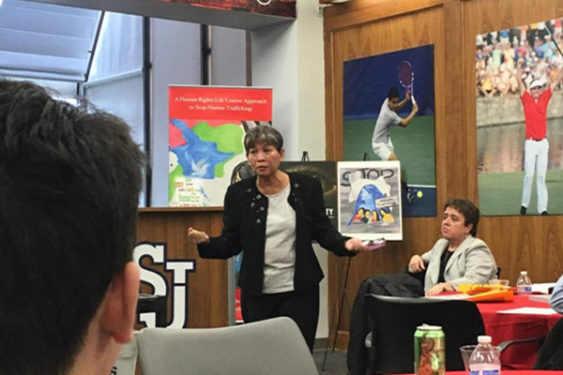
By Nicholas Silverstein, Student Writer
There are many businesses in the world. Some are darker than others, but the darkest among them is human trafficking. This past spring, St. John’s University in Jamaica held its annual conference on human traffickingthat was organized by the university’s Vincentian Center for Church and Society, the university’s chapter of the Ladies of Charity and Catholic Relief Services.
I went with 11 other students from St. John’s Preparatory School in Astoria to gain a deeper understanding of the impact and causes that this crime has on many men, women, and children who are doomed to suffer this cruel way of life.
Sister Angela Reed, R.S.M., from Mercy Global Action at the United Nations’ Catholic Relief Services, opened the conference with background information and defined trafficking as “the selling and ownership of humans that is done for sexual or laboring manners.” Sister Angela explained that humans are sold and kept as slaves of labor, sexual acts, or used for organ/body ownership. She said it’s a reoccurring crime that affects a large number of the world’s population.
Between 20 – 30 million enslaved people exist in the world today and between 600,000 – 800,000 people are trafficked across international borders every year. People stuck in these lives have no way out because their owner can blackmail them or threaten them if they leave or try to leave. For example, a very common victim of trafficking and forced labor are undocumented immigrants. If the worker tries to leave, their owners threaten to report them as illegal which can get them deported or imprisoned. When you are stuck in this life, it’s nearly impossible to escape.
That’s why spreading awareness to this practice is extremely important because those who are trapped in this life cannot speak for themselves. If they could, they would put themselves or others they care about at risk.
One human trafficking victim was present at the conference to talk about her experience. We met Mely Lenario, a woman from the Philippines who was trafficked as a teenager. What she told us was a horrifying story with very sad events. Her story really opened up my mind to how cruel that way of life can be. When Lenario was a child, she witnessed traumatic experiences within her family and was threatened when she tried to intervene. Growing up in poverty, she lived in rough conditions, had little money, and had to walk two hours back and forth from school every day.
Eventually, she had to leave school as a young girl and managed to find work, but the intentions of the managers were much more sinister than she could have imagined. Lenario was sold to traffickers and taken complete advantage of. She became a sex slave and suffered from the torments of her “boss” who threatened her if she didn’t accept clients. Lenario was very afraid and miserable. Her life seemed doomed – until the day she was helped by members of the church. By chance on the street, she met a priest and nun who helped her escape and break away.
Lenario’s story really opened my mind to the evil of human trafficking. I heard firsthand the horrifying conditions that can come from being trafficked. Her story really brought out why human trafficking needs to be stopped and why being educated on the topic is so important. More awareness can lead to more actions taken to stop human trafficking and put an end to this blood-stained business.
Silverstein is a sophomore at St. John’s Preparatory School, Astoria.
